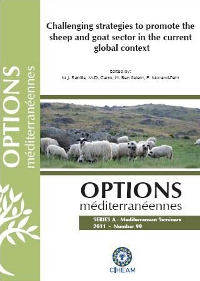| Article précédent | p. 175-179 | Article suivant |
Effects of Aspergillus oryzae on in vitro ruminal fermentation
In the last decades the nutritionists have shown a great interest in a wide variety of microorganisms that, added in small quantities to the diet, could improve the ruminal function, thereby enhancing feeds utilization. The objective of this study was to determine the effect of an Aspergillus oryzae culture on ruminal fermentation under in vitro conditions, using batch cultures of ruminal microorganisms. Forage of Pennisetum purpureum vc Cuba CT-169 was used as substrate for in vitro incubations. Treatments consisted in different doses of a culture of Aspergillus oryzae, and two dose-response experiments were carried out. In the first study the doses 0, 50, 100 and 200 µl of culture/50ml incubation medium were evaluated. In a second stage, five new and lower doses (0, 0.5, 5, 25 and 50 µl/50ml) were probed. In the first study, a decrease (P<0.05) of propionate, butyrate, isoacids and total volatile fatty acids was observed with the dose of 100 µl. Gas production, final pH, ammonia-N concentration, dry matter disappearance, neutral detergent fibre disappearance and true dry matter degradability were not affected (P>0.05) by any dose of A. oryzae culture. When lower doses were evaluated, a decrease (P<0.05) of propionate and a tendency to lower (P<0.10) butyrate and isoacids production were observed with the dose of 25 µl. This dose tended (P<0.10) to increase the acetate:propionate ratio. Doses of 0.5 and 5 µl decreased (P<0.05) final pH. The rest of indicators were not affected (P<0.05) by any treatment. The results of the study suggest that new doses of the additive must be evaluated in order to clarify their effects on ruminal fermentation, but doses to evaluate should not be higher than 100 µl of culture.
Dans les dernières décennies, les nutritionnistes ont montré un grand intérêt pour une large variété de micro-organismes qui, ajoutés en petites quantités au régime, peuvent améliorer la fonction ruminale, et par conséquent l'utilisation des aliments. L'objectif de cette étude était de déterminer l'effet d'une culture d´Aspergillus oryzae dans la fermentation ruminale in vitro en utilisant la technique de la production de gaz. Comme substrat, on a utilisé le fourrage Pennisetum purpureum vc Cuba CT-169. Les traitements ont consisté en différentes doses d'une culture d'Aspergillus oryzae. Dans le premier essai, on a évalué les doses de 0, 50, 100 et 200 µl de culture /50 ml en milieu d'incubation. Dans une seconde phase, on a essayé cinq nouvelles doses plus faibles (0 ; 0,5 ; 5 ; 25 et 50 µl/50ml). Dans la première étude, on a observé une diminution (P<0,05) de la production de propionate, butyrate, iso acides et acides gras volatils totaux pour la dose de 100 µL, tandis que la production de gaz, le pH final, la concentration d´azote ammoniacal, la disparition de matière sèche, la disparition de NDF et la digestibilité réelle de la matière sèche n'ont pas été affectées (P<0,05) par cette dose de culture d' A. oryzae. Quand des doses plus faibles (25 µl) ont eté évaluées, on a observé une diminution (P<0,05) de propionate et une tendance à la diminution (P<0,1) dans les concentrations de butyrate et iso acides. Cette dose a ensuite tendu à augmenter (P<0,1) le rapport acetate:propionate. Les doses de 0,5 et 5 µl ont tendu à diminuer (P<0,05) le pH final. Le reste des paramètres n'a pas été affecté (P<0,05) par aucun traitement. Les résultats de l'étude suggèrent qu'on doit évaluer de nouvelles doses d' A. oryzae (non supérieurs à 100 µl de culture) dans le but de clarifier leurs effets sur la fermentation ruminale.
- [ Afficher ]
- [ Télécharger ]
- [ Exporter la citation ]
Vous pouvez télécharger la citation au format :
- [ Imprimer ]
-
Mots-clés
DIGESTION DU RUMEN, FOURRAGE, IN VITRO, REGIME ALIMENTAIRE, ASPERGILLUS ORYZAECiter cet article
Sosa A., Galindo J., Tejido M.L., Díaz A., Martínez M.E., Saro C., Carro M.D., Ranilla M.J. Effects of Aspergillus oryzae on in vitro ruminal fermentation. In : Ranilla M.J. (ed.), Carro M.D. (ed.), Ben Salem H. (ed.), Morand-Fehr P. (ed.). Challenging strategies to promote the sheep and goat sector in the current global context. Zaragoza : CIHEAM / CSIC / Universidad de León / FAO, 2011. p. 175-179. (Options Méditerranéennes : Série A. Séminaires Méditerranéens; n. 99). 13. International Seminar of the Sub-Network on Nutrition of the FAO-CIHEAM Inter-Regional Cooperative Research and Development Network on Sheep and Goats, 2009/10/14-16, León (Spain). http://om.ciheam.org/om/pdf/a99/00801553.pdf



